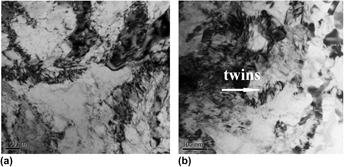Article contents
Role of stacking fault energy and strain rate in strengthening of Cu and Cu–Al alloys
Published online by Cambridge University Press: 20 August 2014
Abstract

Cu and Cu–Al alloys with different stacking fault energies (SFEs) were processed using rolling and the Split Hopkinson pressure bar followed by rolling. The effect of strain rate on the microstructures and mechanical properties of the alloys were investigated using x-ray diffraction analyses, transmission electron microscopy, and tensile tests. Tensile testing results demonstrated that the strength and ductility of the samples increased simultaneously with decreasing SFE. Microstructural observations indicated that the average grain size of the samples decreased with decreasing SFE, but the twin and dislocation densities increased. With decreasing SFE, twinning becomes the dominant deformation mechanism. Our findings indicated that the SFEs significantly affect the strength and ductility of the materials because they play a key role in determining the deformation mechanism. Decreasing the SFE of Cu alloys has proved to be the optimum method to improve the ductility without compromising the strength of the material.
- Type
- Articles
- Information
- Copyright
- Copyright © Materials Research Society 2014
References
REFERENCES
- 6
- Cited by


